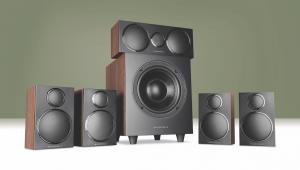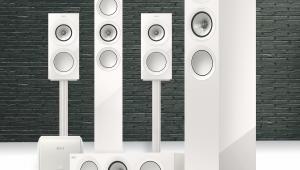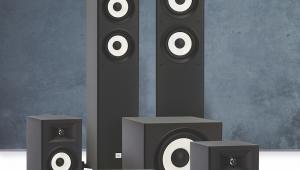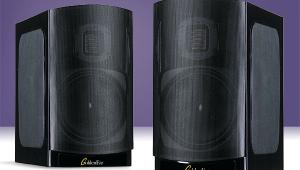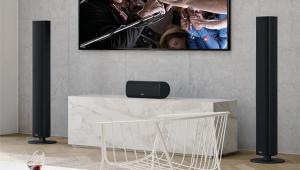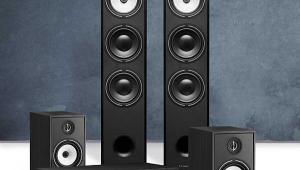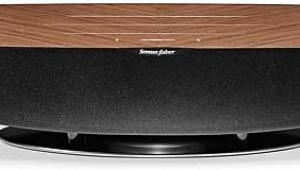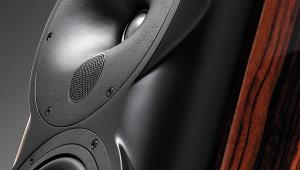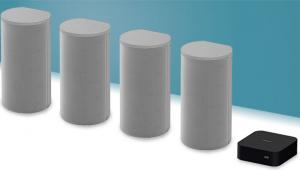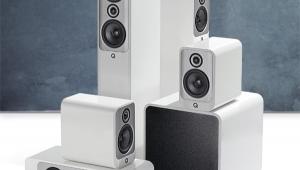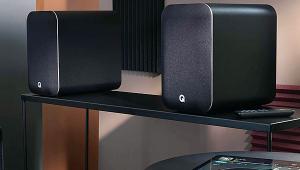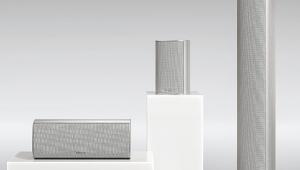Acoustic Energy Neo Max review

Slapping the word ‘Max’ onto the end of your product name doesn’t automatically make it great, as anyone who’s tasted Pepsi Max can attest. But in the case of Acoustic Energy’s Neo Max system it seems entirely appropriate.
AE’s original 5.1-channel Neo V2 system was a serious proposition in the first place, but this beefed-up version adds even more firepower to its already considerable arsenal. It increases the speaker count to 7.1 and swaps the Neo Threes in the original system for a pair of the company’s new Neo Four floorstanders.
This injection of sonic steroids was prescribed after AE’s customers started demanding a more potent floorstanding speaker for the Neo lineup, capable of bringing more detail and bass depth than the smaller Neo Threes could muster. That means a higher price too, but at just under £2,000 you’re still getting a lot of speaker for your money.
Meet the ensembleAlongside the Neo Four fronts (£699 a pair separately), you get a pair of shorter Neo Three floorstanders for the rears (£409 a pair), £229 Neo One bookshelf speakers on surround back duties, the £179 Neo Centre and the £409 Neo Subwoofer.
But first we’ll inspect the new kids on the block. The Neo Fours are an imposing, majestic presence that’ll cast sizeable shadows over your living space with their 1.2m tall, 70-litre cabinets. They weigh a fair amount too. But they have the sort of muscular build quality we love at HCC and much better than you have any right to expect for their price.
But for all their bulk, Acoustic Energy has done a terrific job of making them look elegant and contemporary, with curves all over the shop and a luxurious Vermont walnut or Black Ash finish. Cover the drivers with the magnetic grilles if you want, but I think they look far funkier without them. For setup, you need to screw on the black plinths. Attaching the supplied spikes is entirely up to you.
The Neo Four’s internal design is just as attractive, particularly the 32mm-thick MDF baffle which helps to ensure tight, potent bass response. They use a three-way, triple-ported design, with a 5in aluminium alloy midrange driver, a pair of 6.25in bass drivers and a wide-bandwidth 1in dual-ring radiator tweeter.
Another key element in the Neo Four’s technical make-up is the choice of material used for the magnets. Interestingly, the Neo Fours use Ferrite magnets instead of neodymium, which is used by all the other speakers in the system and is how the range gets its name. (The irony of range-topping speakers not using the technology they’re named after has not escaped us!) But there’s method in the madness – Acoustic Energy’s engineers preferred a ferrite system in order to deliver the extra punch required by these larger, more voluminous cabinets. And what a punch they pack; there’s 200W quoted power handling and a frequency response of 28Hz all the way up to 40kHz.
The rest of the system, from the bookshelf boxes up to the 905mm-high Neo Threes, boasts equally awesome construction. Again, there’s a choice of Vermont and Black Ash finishes and they share the smoothly curved corners as the Neo Fours.
These rear floorstanders are a two-and-a-half way, reflex-loaded design featuring a 1in neodymium ring radiator tweeter, and a pair of 5in low/mid drivers. The two-way Neo One bookshelves lose the second low/mid driver.
The importance of dialogue to your movie enjoyment hasn’t escaped AE’s attention either and as such the Neo Centre boasts the same two-and-a-half way driver array as the Neo Threes. It’s a hefty box though, likely to require quite a reshuffle to house it.
AE hasn’t felt the need to introduce a new subwoofer for this Max system, so you get the same bass-box as the original Neo V2 array. Thankfully it’s up to the task, endowed with a 200W Class A/B amplifier, and an 8.5in drive with a long-throw ferrite magnet.
All this brawn is bundled up in a beautiful box, styled in the same classy-looking finish. You should have no trouble getting it to integrate with the other speakers thanks to the wide range of controls found on the rear panel. Volume, crossover and phase can all be tweaked to your heart’s content, as well as less common adjustments such as notch filters for frequency, Q and attenuation, which can help rectify any problems you have with room acoustics. You also get line-level stereo inputs and outputs, plus a separate line-level input.
Controlled powerWhat all this amounts to is a performance that’s frighteningly potent and heart-meltingly silky all at once. The extra grunt afforded by the addition of the Neo Fours is instantly clear; they fire out frenetic action scenes with greater ferocity, pumping the room full of sound. As a result, the scale of the soundstage is immense.
But despite that, the entire sonic spectrum is delivered with a sophisticated tone and few rough edges to sully your listening pleasure. With the remarkable tracking shot during the refugee camp siege at the end of Children of Men, the Neo Max system shows the full range of its talents. When the army blows up the tower block, the explosion is brutal, conveyed with tautness and depth by the superb subwoofer. And as the debris rains down, it shows its ability to handle delicate high-frequency detail, relaying the popping and rustling as little showers of rock hit the ground with pin-sharp clarity.
The soundstage it conjures is wide and spacious, with distant voices and gunshots drifting in and out of earshot from all over the room. It’s a dynamic, engaging performance, demonstrating power, agility and subtlety from every speaker and throwing considerable force behind the effects that really need it.
And despite the disparity in sizes, Neo Max ensures tonal consistency across the system, creating a wonderfully coherent, tightly-locked sound that immerses you in the action. You can also push them loud without distortion or high-frequency edginess, and they handle everything with a level of composure befitting a far more expensive set of speakers.
I switched over to Hellboy II’s 7.1-channel DTS HD Master Audio soundtrack and was equally bewitched. There isn’t a weak link in the chain. The Neo Threes at the back offer levels of detail insight and bass depth that almost rival the Fours at the front, making the thumping effects during the battle with the Golden Army feel weighty and solid; the Neo Ones are smooth operators too, handling the eerie ambience of the movie’s fantastical settings with sparkling clarity; while the centre channel delivers dialogue with openness and authority. The subwoofer doesn’t let the side down either, resulting in an overall listening experience that borders on an epiphany at this price.
Used as a stereo pair for music, the strength and poise of the Neo Fours again pays dividends. As well as reproducing kick drums and basslines with terrific depth and agility, it digs out nuances higher up the scale and produces vocals that you can really believe in.
This wonderful performance makes the 7.1 Neo Max system an absolute winner in my eyes (and ears), and the fact that you’re getting it for under £2K is an even more compelling reason to check it out.
HCC VERDICT
Acoustic Energy Neo Max
Price: £1,900 Approx
Highs: Lots of box for the money; sensational sound quality
Lows: Might be a little imposing for some rooms; need two people to shift them as they weigh a lot
Performance: 5/5
Design: 4/4
Features: 4/5
Overall: 5/5
Specifications
Neo Four fronts
Drive units: 2 x 6.25in pressed alloy LF cones, 1 x 5in midrange cone, 1 x 1in Neodymium Ring Radiator tweeter
Enclosure: Triple-ported, MDF
Frequency response: 28Hz-48kHz
Sensitivity: 91dB
Power handling: 200W
Dimensions: 203(w) x 1200(h) x 300(d)mm Weight: 28kg
Neo Three rears
Drive units: 1 x 5in pressed alloy cone low-mid driver, 1 x 1in Neodymium Ring Radiator tweeter
Enclosure: Reflex-loaded, MDF
Frequency response: 43Hz-45kHz
Sensitivity: 90dB
Power handling: 170W
Dimensions: 203(w) x 905(h) x 242(d)mm Weight: 14kg Neo Centre
Drive units: 1 x 5in pressed alloy cone low-mid driver, 1 x in Neodymium Ring Radiator tweeter
Enclosure: Reflex-loaded, MDF
Frequency response: 75Hz-40kHz
Sensitivity: 90dB
Power handling: 120W
Dimensions: 480(w) x 178(h) x 195(d)mm Weight: 9kg
Neo One surround backs
Drive units: 1 x 5in pressed alloy cone low-mid driver, 1 x in Neodymium Ring Radiator tweeter
Enclosure: Reflex-loaded, MDF
Frequency response: 60Hz-40kHz
Sensitivity: 89dB
Power handling: 120W
Dimensions: 182(w) x 357(h) x 231(d)mm Weight: 6kg
Neo Sub
Drive units: 8.5in pulp cone with high power long-throw magnet system
Enclosure: Closed box
Frequency response: Down to 26Hz
On board power: 200W
Dimensions: 360(w) x 410(h) x 325(d)mm Weight: 17kg
Connections: Phono stereo input and output, AV line in
 |
Home Cinema Choice #351 is on sale now, featuring: Samsung S95D flagship OLED TV; Ascendo loudspeakers; Pioneer VSA-LX805 AV receiver; UST projector roundup; 2024’s summer movies; Conan 4K; and more
|




